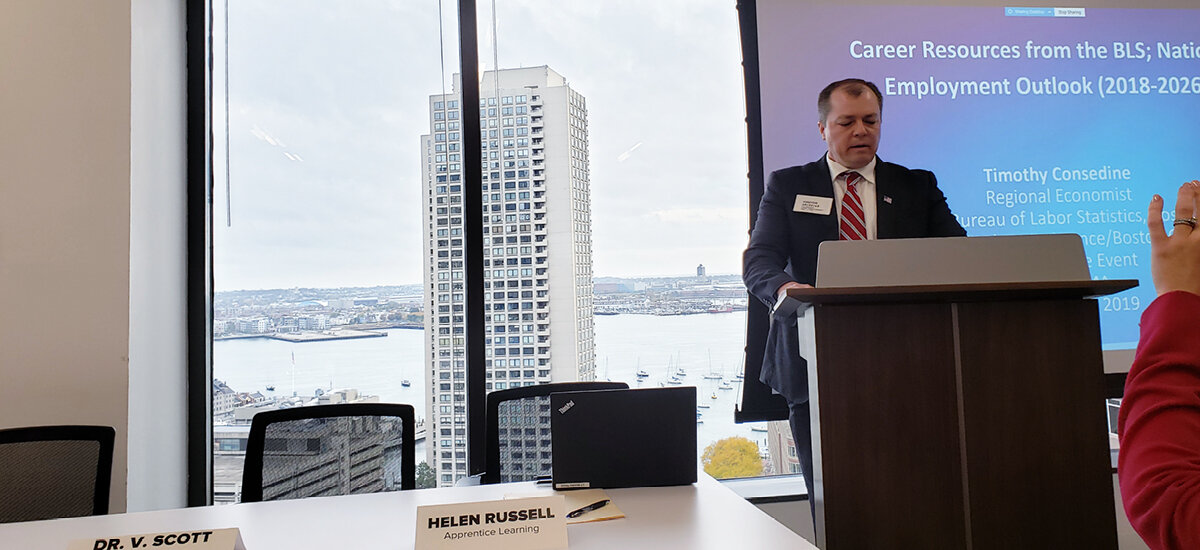Ways to engage students in career exploration
The American Student Assistance (ASA) meeting on October 22nd at the Boston Chamber of Commerce brought together educators, nonprofits and the US Bureau of Labor Statistics to discuss and emphasize the importance of engaging students early in career exploration and pathways, as they start to disengage in the ninth grade. Early exposure to other options such as technical education, associate’s degrees, certificates and apprenticeships can truly motivate students and evolve the popular assumption that a four-year college degree means success.
The distinguished panel included:
Timothy Consedine, from the US Bureau of Labor Statistics
Helen Russell, from Apprentice Learning
Dr. Scott Solberg, from Boston University College of Education and Human Development
Cathleen Finn, from Verizon’s Community Relations and Workforce Development, also served as moderator of the panel
Laura Dziorny, from the Rennie Center Education Research & Policy
Disengaged Youth
The Rennie Center’s research on disengaged young people reports that Boston’s “Opportunity Youth” (OY), defined as unemployed or underemployed 16-24 year olds (most of whom have already earned a high school diploma) is “disconnected in a way that can lead to lower lifetime earnings and a higher likelihood of social isolation”. Furthermore, this disconnection is disproportionately experienced among students of color: African American (9.8%) and Latino (7.1%) vs White (1.5%).
OY participants from the report’s focus groups on career exploration and educational experiences shared that:
“Everything is driving to college, it is all for college.”
“It’s hard to get something unless you know someone”
“I didn’t know what I wanted to do. I didn’t understand what I was passionate about.”
OY feel the challenges of not knowing how to navigate the system and having the right connections, and become lost when their interest isn’t college.
According to the US Bureau of Labor Statistics, 75% of current jobs require a post-secondary degree, but less than 50% of current 9th graders will achieve this. It’s also interesting to note that many of the fastest growing jobs may not be the ones students are familiar with—as the jobs of tomorrow are not the same jobs that they have been historically.
Ways we can Engage Middle Schoolers in Career Exploration
Let the exploration be student driven
Stop pushing toward college, but encourage career readiness
Provide professional role models
Talk about talent instead, as many students don’t even know they have it
Build confidence
Show how education is relevant to skill development
Make learning experiences flexible
Take them outside the classroom to experience the real world, like an office visit or job shadowing
Build real world skills
Encourage a growth mindset of persistence and problem-solving
Bring in the rest of the community, from parents to businesses
Begin with paid summer jobs
How Citizen Schools engages today
It’s no surprise that all the suggestions align with the mission, vision and values of Citizen Schools. Many of these suggestions are supported today through apprenticeship programs, with Catalyst STEM mentors, or through community building via Makers + Mentors Network. It’s also encouraging to see the breadth of education-focused leaders moving in the same direction and understanding what a critical time this is to incorporate real-world practices to give students the best opportunities to develop passion and engage in their future career pathways.
Helpful Career Resources
Bureau of Labor Statistics Occupational Outlook Handbook: https://www.bls.gov/ooh/
Bureau of Labor Statistics Career Outlook, with narratives from someone in the field: https://www.bls.gov/careeroutlook/
Bureau of Labor Statistics Career Exploration, where student can explore career pathways based on areas of interest: https://www.bls.gov/k12/students/careers/career-exploration.htm


